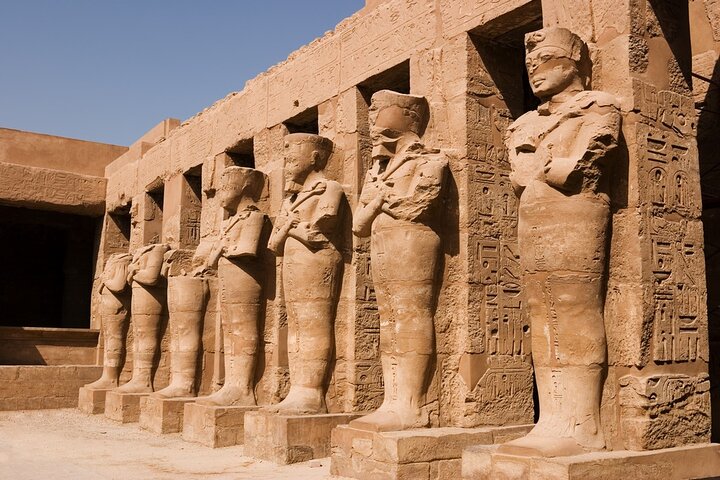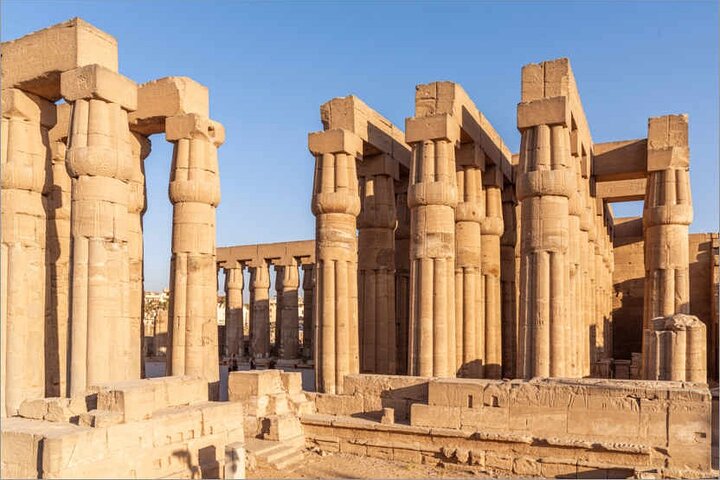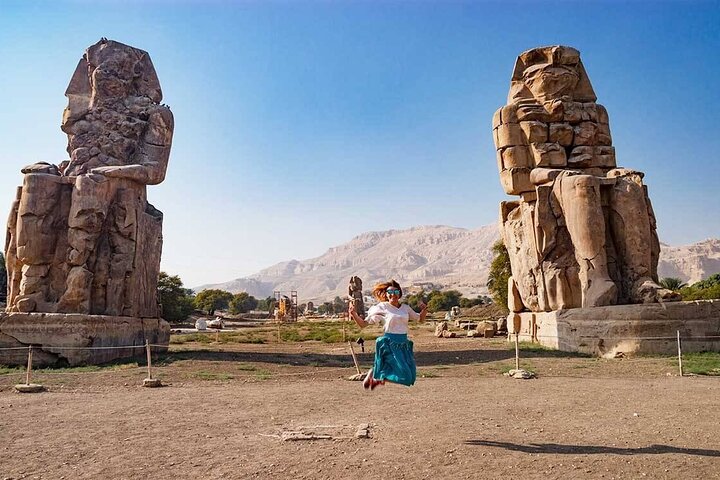2-Day Private Tour of Luxor
Share this tour

Offered languages
- German
- English
- Italian
- French
- Spanish
2-day private tour of Luxor offers an immersive journey into ancient Egypt's grandeur. Day 1 focuses on the East Bank, beginning with the majestic Karnak Temple, a sprawling complex of sanctuaries, obelisks, and pylons dedicated to the Theban Triad. Afterwards, explore the stunning Luxor Temple, beautifully illuminated in the evening, with its grand colonnades and intricate reliefs. Day 2 shifts to the historic West Bank, starting with a breathtaking hot air balloon ride over the ancient sites at sunrise. Descend to explore the Valley of the Kings, the pharaohs' burial ground, before visiting the unique terraced Temple of Hatshepsut. Conclude your tour with the imposing Colossi of Memnon, silent guardians of a forgotten temple. This itinerary provides a comprehensive and unforgettable exploration of Luxor's most iconic treasures.
What's Included
Meeting and pickup
pick you up form any hotel at luxor
Itinerary
-
1Temple of Karnak
Your Egyptologist Guide will pick you up from your starting point to accompany you for your day tour to the East Bank to visit the magical Karnak Temples, the greatest example of worship in history and was dedicated to the God Amon his wife Mut.
2 hours • Admission ticket not included -
2Luxor Temple
Then continue onto visit Luxor Temple which was built by Amunhotep III in 18th Dynasty in the New Kingdom and it was completed by Ramesses II during the 19th Dynasty. King Ramses II was the most famous king and ruled Egypt for about 67 years. It was dedicated to the great god Amun-Ra his wife Mut and their son Khonsu together representing the Theban triad. Enjoy visiting Obelisk of Ramses II in front of the 1st Pylon. Return to your starting point in Luxor.
1 hour 30 minutes • Admission ticket not included -
3
The adventure typically begins before dawn with a **hot air balloon ride** over the West Bank. As the sun slowly peeks over the eastern horizon, painting the sky with hues of orange and pink, you'll ascend into the tranquil morning air. From this unique vantage point, the landscape of Luxor unfolds beneath you. The fertile green ribbon of the Nile contrasts sharply with the vast, ochre desert. The winding paths of the Valley of the Kings, the imposing silhouette of Hatshepsut's Temple, and the solitary figures of the Colossi of Memnon become part of a grand tapestry, offering a perspective impossible to grasp from the ground. This serene and awe-inspiring experience provides a profound sense of the scale and timelessness of this ancient civilization, creating memories that linger long after you've touched down.
1 hour • Admission ticket included -
4Valley of the Kings
The journey continues on solid ground to the **Valley of the Kings**. Tucked away in a desolate wadi, this is the burial ground of pharaohs from the New Kingdom (1539-1075 BC), including the famous Tutankhamun. Stepping into the valley feels like entering a sacred, hushed realm. The tombs, carved deep into the rock, were designed to protect the pharaohs and their treasures for eternity. While photography is often restricted inside, the vibrant hieroglyphs and meticulously preserved murals adorning the walls are a testament to the artistic skill and elaborate funerary beliefs of the ancient Egyptians. Each tomb tells a story through its intricate depictions of gods, goddesses, and the journey to the afterlife, offering a fascinating glimpse into their complex religious cosmology. The sheer number of tombs and the artistry within each one are truly astounding.
2 hours • Admission ticket not included -
5Temple of Hatshepsut at Deir el Bahari
Next on the itinerary is the magnificent **Temple of Hatshepsut**, also known as the Djeser-Djeseru, meaning "Holy of Holies." This mortuary temple is a striking example of ancient Egyptian architecture, designed by Senenmut, Hatshepsut's architect and probable lover. Unlike many other temples, Hatshepsut's is built into a cliff face, rising in a series of three grand terraces that seamlessly blend with the surrounding landscape. Hatshepsut, one of the most powerful female pharaohs, boldly ruled Egypt for over two decades. The temple's reliefs depict her divine birth, expeditions to Punt, and her relationship with the gods. Despite attempts to erase her from history after her death, her legacy endures within these impressive walls, showcasing her power, ambition, and architectural prowess.
2 hours • Admission ticket not included -
6Colossi of Memnon
Finally, the tour concludes with a visit to the **Colossi of Memnon**. These two massive stone statues depict Amenhotep III (1386–1349 BC) in a seated position, his hands resting on his knees. Standing approximately 18 meters (60 feet) high, they once guarded the entrance to Amenhotep III's mortuary temple, which has long since disintegrated. While the temple itself is gone, these colossal figures remain, silent sentinels against the backdrop of the Theban hills. In antiquity, the northern colossus was famously known to "sing" at dawn, a phenomenon caused by the expansion of dew within cracks in the stone. Though the "singing" has ceased due to repairs, the Colossi of Memnon continue to stand as a powerful reminder of the immense scale and grandeur of ancient Egyptian craftsmanship and the ephemeral nature of even the most magnificent structures.
30 minutes • Admission ticket free
East Bank ( Temple Of Luxor - Temple Of Karnak )
West Bank ( Hot Air Balloon - Valley Of The Kings - Hatshbsut Temple - Colossi Of Memnon )
Additional info
- Infants and small children can ride in a pram or stroller
- Public transportation options are available nearby
- Infants are required to sit on an adult’s lap
- Suitable for all physical fitness levels
Tags
Cancellation Policy
For a full refund, cancel at least 24 hours before the scheduled departure time.
Show more
Cancellation Policy
- For a full refund, you must cancel at least 24 hours before the experience’s start time.
- If you cancel less than 24 hours before the experience’s start time, the amount you paid will not be refunded.
- Any changes made less than 24 hours before the experience’s start time will not be accepted.
You can cancel up to 24 hours in advance of the experience for a full refund.
Your guide to the flawless travel experience




















